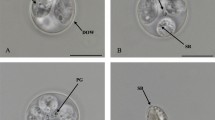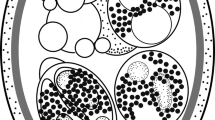Abstract
Five new species of Eimeria are described from lizards. Eimeria baltrocki n. sp. was found in the berber skink, Eumeces schneideri, from Egypt. The oöcysts are cylindroidal, averaging 38 × 18.3 μm, with a single thick oöcyst wall. Most oöcysts possess a single polar granule; a micropyle and oöcyst residuum are absent. The sporocysts are ellipsoidal and average 11.5 × 8.1 μm, each with a large, globular sporocyst residuum; the Stieda body is absent. Eimeria anolidis n. sp. is described form the common anole, Anolis carolinensis, from Florida, USA. The oöcysts are cylindroidal and average 31 × 15.8 μm with a thick, single-layered oöcyst wall. Two polar granules are usually present; a micropyle and oöcyst residuum absent. The sporocysts are ellipsoidal and average 9.4 × 7.5 μm with a globular sporocyst residuum; the Stieda body is absent. Eimeria guyanensis n. sp is recorded in the ameiva, Ameiva ameiva, from Guyana, South America. The oöcysts are spherical to subspherical, average 19.0 × 17.8 μm and possess a thick, single-layered oöcyst wall. Numerous polar granules are present (n > 5); a micropyle and oöcyst residuum are absent. The sporocysts are spherical to subspherical, average 7.5 × 7.8 μm and possess a compact globular sporocyst residuum; the Stieda body is absent. Eimeria phelsumae n. sp. was recovered from the giant day gecko, Phelsuma madagascariensis grandis, from Madagascar, which harboured a simultaneous infection of E. brygooi. The oöcysts measured 32 × 15 μm and are cylindroidal without polar granules, a micropyle or oöcyst residuum, or a Steida body. The sporocysts are ellipsoidal and average 9.8 × 7 μm, with a loosely clumped, granular sporocyst residuum; the Steida body is absent. Eimeria leiocephali n. sp. was discovered in the faeces of the ornate ground iguana, Leiocephalus barahonensis, from Haiti. The oöcysts are spherical to subspherical, 21 × 19 μm, and contain a number of polar granules (n > 5); a micropyle and oöcyst residuum are absent. The sporocysts are spherical, 8 μm in diameter and lack a sporocyst residuum. Eimeria turcicus and E. lineri were found in faeces of Hemidactylus turcicus turcicus from the host's country of origin, Turkey.
Similar content being viewed by others
References
BoveeE.C. (1971) New species of Eimeria from lizards of Japan. Transactions of the American Microscopical Society, 90, 336–343.
BoveeE.G. & TelfordS.R.Jr. (1965) Eimeria noctisaurus sp. n. a coccidian from the lizard, Klauberina riversiana. Journal of Parasitology, 51, 325–330.
CariniA. (1938) Eimeria maboia n. sp. parasita do intestino do Mabuja maboia. Archivos de Biologia (Sao Paulo), 22, 10.
CariniA. & PintoC. (1926) Estudos sobre coccideas. Archivos de Biologia (Sao Paulo), 11, 83–86.
DavronovO. (1985) Coccidia in reptiles from the southern Uzbekistan. Parazitologiya, 19, 158–161.
DuszynskiD.W. (1969) Two new coccidia (Protozoa: Eimeriidae) from Costa Rican Lizards with a review of the Eimeria from lizards. Journal of Protozoology, 16, 581–585.
LainsonR. (1968) Parasitological studies in British Honduras. IV. Some coccidial parasites of reptiles. Annals of Tropical Medicine and Parasitology, 62, 260–266.
MatuschkaF.-R. & BannertB. (1986) Eimeria tarentolae n. sp. from the Moorish gecko, Tarentola mauritanica. Journal of Protozoology, 33, 309–311.
MatuschkaF.-R. & BannertB. (1987) New eimeriid coccidia from the Canarian lizard Gallotia galloti Oudart, 1839. Journal of Protozoology, 34, 231–235.
McAllisterC.T., UptonS.J. & FreedP.S. (1988) Eimeria lineri sp. n. (Apicomplexa: Eimeriidae) from the Mediterranean Gecko, Hemidactylus turcicus (Sauria: Gekkonidae), in Louisiana and Texas. Proceedings of the Helminthological Society of Washington, 55, 256–259.
PapernaI. & LandsbergJ.H. (1989a) Fine structure of endogenous stages of Eimeria turcicus developing in gall bladder epithelium of the gecko Hemidactylus turcicus. South African Journal of Zoology, 24, 251–259.
PapernaI. & LandsbergJ.H. (1989b) Description and taxonomic discussion of eimerian coccidia from African and Levantine geckoes. South African Journal of Zoology, 24, 345–355.
RuizA. (1959) Eimerid intermedia n. sp., Parasita de la lagartija Anolis intermedius Peters. Revista de Biologica Tropical, 7, 109–112.
RuzievK.H. & DavronovO. (1984) Reptile coccidia in the Southern Uzbekistan SSR-USSR. Uzbekeskii Biologischeskii Zhurnal, 6, 35–38. (In Russian)
UptonS.J. & BarnardS.M. (1987) Two new species of coccidia (Apicomplexa: Eimeriidae) from Madagascar Gekkonids. Journal of Protozoology, 34, 452–454.
UptonS.J., McAllisterC.T. & FreedP.S. (1988) Eimeria turcicus n. sp. (Apicomplexa: Eimeriidae) from the Mediterranean gecko, Hemidactylus turcicus (Sauria: Gekkonidae). Journal of Protozoology, 35, 24–25.
Author information
Authors and Affiliations
Rights and permissions
About this article
Cite this article
Daszak, P., Ball, S.J. Five new species of Eimeria (Apicomplexa: Eimeriidae) from lizards. Syst Parasitol 20, 141–147 (1991). https://doi.org/10.1007/BF00007390
Accepted:
Issue Date:
DOI: https://doi.org/10.1007/BF00007390




